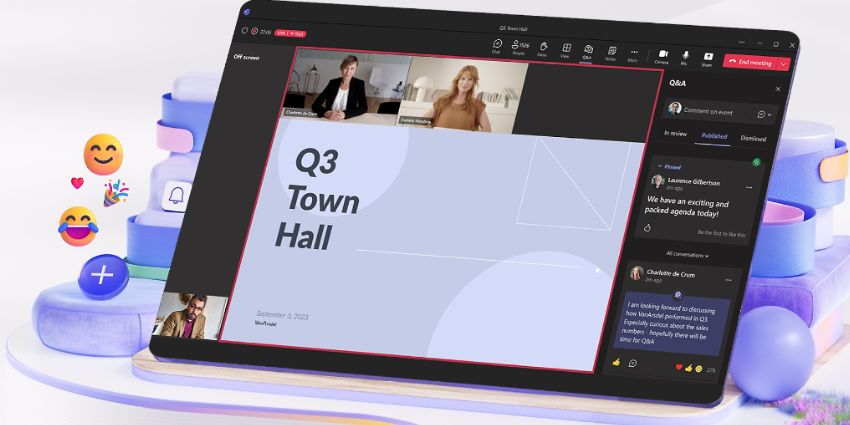It has certainly been a busy few months within Cisco‘s collaboration division. 2018 has already seen new acquisitions, a massive re-branding exercise, strategic directional changes and some pretty high profile departures. So just a typical quarter within a specific division for the global tech giant? Not quite. As arguably the biggest global player within the collaboration sector we take a more in-depth look at the changing face of Cisco’s collaboration proposition.
Rebranding Collaboration
The biggest event in the calendar when it comes to collaboration is their Cisco Collaboration Summit which takes place every year. This year’s event took place earlier this month in Phoenix, Arizona and was the platform for a series of big announcements. The main news was that Cisco ditched the name Spark for their collaboration platform and renamed it Webex Teams. Utilising the world renowned brand that Webex (formally WebEx) represents has been widely lauded as a smart move within the industry but nonetheless such a change certainly represented somewhat of a risk and an acknowledgement from Cisco that Spark wasn’t hitting the mark.
Strategic change
The Collaboration Summit was also the opportunity for a shift in focus, as well as the rebranding exercise. Webex formerly reserved for the meeting platform will now encompass three key pillars. Newly dubbed the Cisco Collaboration Suite it now contains: Cisco Webex Calling, Webex Meetings and Webex Teams, formerly Cisco Spark. The three will now cover the entire eco-systems of services that Cisco make available to their customers for communication and collaboration.
Cisco Acquisitions
The only collaboration related acquisition in 2018 so far was announced yesterday when news emerged that Cisco have acquired Accompany for $270 million. Accompany are database specialists who utilise artificial intelligence to create enhanced professional networking databases that provide more detailed information on members. Their Founder and CEO, Amy Chang has been a member of Cisco’s board of directors since 2016 but will step down from that role to become Head of Cisco’s collaboration division. It appears that Cisco may be looking to utilise Accompany’s database system to provide more detailed user profiles within their pre-exisitng collaboration suite products, Webex Teams or Meetings. As well as the Accompany announcement the completion of the BroadSoft deal was confirmed as one of Cisco’s biggest ever acquisitions for around $2 billion.
High Profile Departures
At the start of 2018, SVP and General Manager for Cloud Collaboration, Jens Meggers, left Cisco, moving on to co-found a networking start-up. Then this week we reported that Rowan Trollope, SVP and GM of the Applications Group will be leaving to take on a new role as CEO of cloud communication software provider Five9. Trollope and Meggers have been two of the most recognisable faces within Cisco’s collaboration division over recent years and their respective departures have certainly raised questions within the industry.
Reasons behind the changes
It may well prove that all of the above changes are unrelated, purely occurring by chance within a period of a few months. However the proximity on the timeline may imply that there is no co-incidence.
Let’s explore Cisco’s recent performance and competition:
Cisco Performance
At this point it seems prudent to examine how the Cisco Collaboration product group has been performing. The Cisco collaboration product group includes Unified Communications, Conferencing (including WebEx), Collaboration endpoints, and business messaging (formerly Cisco Spark).
Full annual financial details released in Cisco’s 2017 report, covering July 2016 to July 2017, showed a 2% decline in collaboration revenue over their last fiscal year. Although the figures were in decline, the 2% contraction was lower than that of total company revenue which decreased by 4% across all product categories.
 A decline of 2% represents a decrease of $74 million year on year. Cisco cite decreased revenue from phones sales as the reason behind the decline. It is interesting that the report does mention Webex specifically.
A decline of 2% represents a decrease of $74 million year on year. Cisco cite decreased revenue from phones sales as the reason behind the decline. It is interesting that the report does mention Webex specifically.
“(the revenue decrease was) partially offset by continued growth in Conferencing revenue. The growth in Conferencing revenue resulted from higher usage and recurring SaaS revenue from Webex”
So even with the lack of exact figures it does appear that Webex was one aspect of the collaboration product group that was performing well. As a percentage of Cisco’s overall revenue the collaboration product group has seen steady growth over the past two years from 10.6% in 2015 to 11.7% in 2016 and in July it represented 12% of Cisco’s overall global revenue.
The most concerning aspect from a performance perspective can possibly be gleaned with a different approach. If you analyse the revenue growth over the past three fiscal years the picture for collaboration during 16/17 is one of stagnation.
From July 2015 to July 2016 the collaboration product group grew by 8.7% or $348 million. Not only has that level of growth not been witnessed through 16/17 but the figures have declined. The decline in revenues and stall in growth of the collaboration product group, given its increasing weight as part of Cisco’s overall revenue, must be a concern.
Competition – Who is eating Cisco’s Lunch?
Rivals within the collaboration space have intensified their efforts and further entrants to the market continue to target share in a growing industry. There are various different types of competition for Cisco and due to their expansive portfolio they are being challenged from all angles. Cisco have to compete with both the legacy and pure cloud vendors as well as the disruptive challenger brands.
Tech giant Microsoft have focused their development on Microsoft Teams and a constant addition of new features, as well as functions being duplicated from Skype for Business, continue to strengthen one of Cisco’s main rivals. Slack still hold a large market share within the chat and collaboration application space and their continued growth increases competition in the sector.
As well as strong competition within chat and collaboration applications Cisco face increasing rivalry within the meeting, web conferencing and video communication landscape. Zoom have garnered market share rapidly and other propositions from the likes of BlueJeans, GoToMeeting and Google Hangouts are just some of the alternatives providing viable solutions. Although Webex does appear, at least in the most recent figures, to be one particular aspect of the Cisco collaboration product group that is performing well.
In the legacy vendor space Mitel have recently been acquired and are focusing more on their cloud proposition. After emerging from chapter 11 Avaya have consolidated and enhanced their portfolio with the acquisition of Spoken and the formation of Zang provides further alternatives. The cloud native providers challenging Cisco’s existing market are also threatening with Fuze, RingCentral, 8×8 and Vonage all experiencing dramatic growth.
The substantial shadows of fellow tech giants Amazon, Facebook and Google also loom over the collaboration space with no-one entirely sure how successful and disruptive they will be to the current status quo.
One thing is for sure there is more competition for Cisco in the collaboration space than ever before.
Reaction
We spoke to the Chief Technology Officer at Modality Systems, Nick Seagrave, for further analysis.
“The recent announcements suggest interesting times ahead at Cisco.”
“First, dropping the Spark brand, then rebranding Webex, and then the news that Rowan Trollope had left to join Five9. Add to that the fact that Cisco has acquired Accompany, which specialises in Artificial Intelligence and Amy Chang is moving over to head up the Collaboration Team, Cisco are definitely making some big changes. It’s interesting to me that Rowan had previously made the move into an Internet of Things role at Cisco, but is now going back to a Unified Communications focus with a Cloud contact center provider; I think this shows he still thinks Cloud UC is an area for growth.”
“It will be interesting to watch how the changes unfold and what is set to come from Cisco over the coming months.”
Supposition
Considering the increased competition, within the collaboration and communication space, and the financial performance of the product group we can speculate that the changes we have seen at Cisco are no coincidence. It would seem entirely plausible that their board have identified some failings and are aiming to address them. Strategic changes, rebranding, acquisitions and high profile departures are all a part, or consequences, of a pretty drastic transformation.
All of the changes have, generally, been greeted positively within the industry but it’s very early to tell how successful the combination will prove. Change, within advancing technology markets particularly, is inevitable and crucial to success but is this too much too quickly? Only time will tell if Cisco have found the ideal balance.







